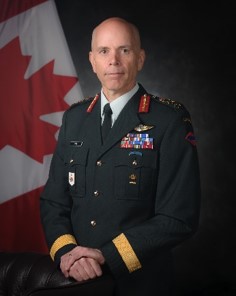March 2020 - Commander Canadian Army - LGen Wayne Eyre, MSC, CD
Archived content
This page was proactively published to meet the requirements of the Access to Information Act. It is a historical record which was valid when published, but may now contain information which is out of date.
Biography
- Appointed 20 August 2019, 35 years of service
- Experience as an embedded senior leader with the United Nations, NATO and the US Army’s prestigious XVIII Airborne Corps
- Commanded forces in Cyprus, Croatia, Bosnia, Afghanistan, and South Korea
- First non-American Deputy Commander of the United Nations Command in South Korea
- Was a key contributor of the human resources portions of the defence policy, Strong, Secure, Engaged.

Mandate
- As part of the Canadian Armed Forces, the Canadian Army force generates land capabilities for the achievement of Canadian defence objectives across the full spectrum of operations
- Work alongside whole-of-government, whole-of-nation colleagues, non-governmental agencies and international partners
- Commander Canadian Army is the Departmental Champion for Indigenous Peoples. The Army promotes engagement with Indigenous communities through a variety of programs, such as summer programs for Indigenous youth
Key facts
The Army consists of:
- 23,000 Regular Force
- 19,000 Army Reserve
- 5,200 Canadian Rangers
- 3,300 Civilians
Budget:
- $935M Operating Budget (Fiscal Year 19-20)
Allocation of Capital Project Funding:
- $17.8B for Army equipment projects over the next 20 years (managed by ADM (Materiel)
Primary location(s):
- 11 Army Bases and 169 Armouries in 117 communities across Canada
- 185 Ranger patrols in over 200 remote communities
- 1150 personnel currently (31 July 2019) on expeditionary operations (Eastern Europe, Africa, Iraq/Kuwait, etc.)
Key Partners
Internal:
- Vice Chief of Defence Staff
- Royal Canadian Navy, Royal Canadian Airforce
- Canadian Special Operations Forces Command
- Strategic Joint Staff
- Canadian Joint Operations Command
- Chief Military Personnel
- Assistant Deputy Minister (Infrastructure and Environment)
- Assistant Deputy Minister (Materiel)
- Assistant Deputy Minister (Finance)
- Assistant Deputy Minister (Science and Technology) Defence Research and Development Canada
External:
- North Atlantic Treaty Organization
- US, Australian, British, and New Zealand Armies
- Public Safety
- Veterans Affairs Canada
- Law enforcement (federal, provincial, municipal)
- Local communities (through bases and Reserve units); service clubs Post Secondary Institutions
Top issues for the Canadian Army
Posturing for Concurrency of Operations
- Conduct a thorough review of the system we use to ensure committed elements of the Army are ready for domestic and international tasks
- Maintain the level of training in basic warfighting skills across the Army
- Reinforce the leadership skills of our emerging leaders with the skillsets that allow us to adapt to the ever-changing security environment
Strengthening the Army by Operationalizing the Army Reserve
- Grow the Army Reserve by reducing hiring times from more than 90 days to less than 30 days
- Continue to provide Full Time Summer Employment for the first four years of Army Reserve service (7,200 in 2018, projected 9,000 in 2019)
- Continue to assign Army Reserve units enhanced roles to provide full time capabilities through part time service
Total Health of the Force
- Develop soldiers’ resilience (physical, emotional, social, spiritual, intellectual and family health)
- Take swift and judicious action to stamp out inappropriate behaviour
- Promote diversity and integration, ensuring we optimize effectiveness and attract the best talent from across Canadian society
- Raise awareness of the rich tradition experience, and contribution of our Indigenous Peoples
Managing Capability Gaps and Introducing New Capabilities
- Work with stakeholders to deliver the Army’s portion of the Capital Program
- 52 major projects to be implemented by 2025
- Ensure interoperability of our capabilities with our key partners
- Continue to adopt business analytics to enhance decision making
Page details
- Date modified:

